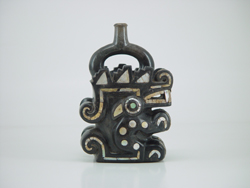 W
WNative American pottery is an art form with at least a 7500-year history in the Americas. Pottery is fired ceramics with clay as a component. Ceramics are used for utilitarian cooking vessels, serving and storage vessels, pipes, funerary urns, censers, musical instruments, ceremonial items, masks, toys, sculptures, and a myriad of other art forms.
 W
WBarro negro pottery is a style of pottery from Oaxaca, Mexico, distinguished by its color, sheen and unique designs. Oaxaca is one of few Mexican states which is characterized by the continuance of its ancestral crafts, which are still used in everyday life. Barro negro is one of several pottery traditions in the state, which also include the glazed green pieces of Santa María Atzompa; however, barro negro is one of the best known and most identified with the state. It is also one of the most popular and appreciated styles of pottery in Mexico. The origins of this pottery style extends as far back as the Monte Albán period and for almost all of this pottery's history, had been available only in a grayish matte finish. In the 1950s, a potter named Doña Rosa devised a way to put a black metallic like sheen onto the pottery by polishing it before firing. This look has made the pottery far more popular. From the 1980s to the present, an artisan named Carlomagno Pedro Martínez has promoted items made this way with barro negro sculptures which have been exhibited in a number of countries.
 W
WCord-marked pottery or Cordmarked pottery is an early form of a simple earthenware pottery made in precontact villages. It allowed food to be stored and cooked over fire. Cord-marked pottery varied slightly across the world, depending upon the clay and raw materials that were available. It generally coincided with cultures moving to an agrarian and more settled lifestyle, like that of the Woodland period, as compared to a strictly hunter-gatherer lifestyle.
 W
WGran Coclé is an archaeological culture area of the so-called Intermediate Area in pre-Columbian Central America. The area largely coincides with the modern-day Panamanian province of Coclé, and consisted of a number of identifiable native cultures. Archaeologists have loosely designated these cultures by pottery style. The poorly studied La Mula period ranged from 150 BC to AD 300. It was followed by the Tonosi period, from AD 300 to AD 550, and by the Cubita period, from AD 550 to AD 700. A unified Native American culture appears to have flourished in this area from approximately 1200 BC until the 16th century.
 W
WCeramics in Mexico date back thousands of years before the Pre-Columbian period, when ceramic arts and pottery crafts developed with the first advanced civilizations and cultures of Mesoamerica. With one exception, pre-Hispanic wares were not glazed, but rather burnished and painted with colored fine clay slips. The potter's wheel was unknown as well; pieces were shaped by molding, coiling and other methods,
 W
WPretty Ladies is the name archaeologists gave to pre-Columbian female figurines in Mexico, from the Chupicuaro, Michoacan, and Tlattlco cultures at the beginning of the 20th century.
 W
WThe Moche Crawling Feline is a specific stirrup spout vessel dating from 100—800 CE. This Moche ceramic effigy is currently in the collection of Larco Museum, in Lima, Peru. It comes from the North Coast of Peru. It represents a zoomorphic character: a lunar dog, or a crawling feline.
 W
WA qiru is an ancient Andean drinking vessel used to drink liquids like alcohol, or more specifically, chicha. They can be made from wood, ceramics, silver, or gold. They were traditionally used in Andean feasts.